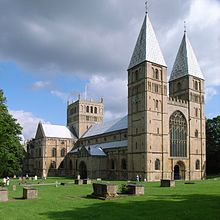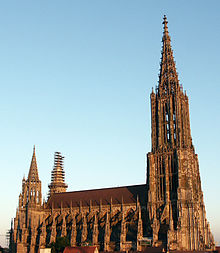Minster (church)

Minster is an honorific title given to particular churches in England, most notably York Minster in Yorkshire, Westminster Abbey in London and Southwell Minster in Nottinghamshire.
The term minster is first found in royal foundation charters of the 7th century, when it designated any settlement of clergy living a communal life and endowed by charter with the obligation of maintaining the daily office of prayer. Widespread in 10th-century England, minsters declined in importance with the systematic introduction of parishes and parish churches from the 11th century onwards. The term continued as a title of dignity in later medieval England, for instances where a cathedral, monastery, collegiate church or parish church had originated with an Anglo-Saxon foundation.
Eventually a minster came to refer more generally to "any large or important church, especially a collegiate or cathedral church". bringing the total number of current Church of England minsters to 31 (listed below).
The term also exists in German as "Münster" and is used mainly for Protestant churches.
Etymology

The word minster (
The modern English term "monastery" does not express the same connotations as the Latin monasterium, from which it derives, or the Old English mynster. This is because the term has come to be associated with
By the tenth century, a gradual distinction between a "church" and a "mynster" began to emerge.[8] For instance, in the Leechdoms, the sixteenth day was propitious for establishing a mynster, and the sixth day of the moon for founding a church.[8] This suggests that by the tenth and eleventh centuries, mynster was being used to refer to a "superior church" which was regarded as long-established and to which people paid their dues.[8]
An early appearance was in the
The modern German term "Münster" is the translation for minster. Monastery or cloister is called "Kloster".
History
Early and mid Anglo-Saxon periods
The first minsters in the English-speaking parts of Britain were founded in the century after the
Alan Thacker states:
The term 'minster' was applied by the Anglo-Saxons to all religious communities, whether of monks proper or of secular clergy, a usage which reflects the fact that many early Anglo-Saxon monasteries had assumed the pastoral role which was ultimately the principal distinction of the secular college. Early Anglo-Saxon monks might baptize, preach, and administer the sacraments to the laity in their locality, and distinctions were further blurred by the existence of 'double monasteries' of nuns and secular clerks. In the last resort, however, monks could be free of pastoral obligations, while the secular minster always had its parish ('parochia') over which it exercised extensive and well-defined rights, including control over baptism and burial and the receipt of various financial dues such as church-scot and tithe.[10]
The word derives from the
Minsters were commonly founded by the king or by a royal
Late Saxon and Norman periods
Following the English recovery in the 10th century, surviving minsters were often refounded in accordance with the new types of collective religious bodies then becoming widespread in
In the 11th and 12th centuries former lesser minsters and field churches, typically served by individual
Late-20th- and 21st-century additions
The Church of England has designated additional minsters in the 20th and 21st centuries, by adding an honorific title to existing parish churches. These have included
Current usage in England
| Status | Examples | |
|---|---|---|
| Cathedrals | Time immemorial | |
| 19th-century elevation | ||
| Parish churches | Former cathedral |
|
| Former collegiate church |
| |
| Parish church |
| |
| Parish church (recent elevation) |
| |
| Minster status preserved in placenames | ||
| Ruins | South Elmham Minster | |
In German-speaking countries
Some churches have the title Münster, and some churches are officially one but do not carry it in their name. Examples include:
- Basel Minster
- Bern Minster
- Essen Minster
- Freiburg Minster
- Konstanz Minster
- Salem Minster
- Ulm Minster
Footnotes
- ^ a b c "Minster". Oxford English Dictionary Online. Retrieved 16 February 2009.
- ^ a b "St Mary's becoming a Minster church". St Mary Magdalene Church. 5 February 2022. Retrieved 21 April 2022.
- ^ Morris 1989, p. 128; Foot 2006, p. 4.
- ^ Foot 2006, p. 4.
- ^ Foot 2006, pp. 4–5.
- ^ Foot 2006, p. 5.
- ^ Foot 2006, pp. 5–6.
- ^ a b c Morris 1989, p. 128.
- ^ John Blair (2005). The Church in Anglo-Saxon Society. OUP.
- ^ Thacker, Alan (1985). "Kings, Saints and Monasteries in Pre-Viking Mercia". Midland History. X. University of Birmingham: 1–2.
- ^ Joe Hillaby, Ledbury, a medieval borough, Logaston 2nd ed. 2005
- ^ "Church raised to minster status". BBC. 16 November 2004. Retrieved 16 February 2009.
- ^ "Mother Church becomes a Minster". BBC. 2 March 2009. Retrieved 12 March 2009.
- ^ "Parish church gets Minster status". BBC News. 15 April 2010.
- ^ "Croydon Parish Church to become a Minster". Diocese of Southwark. 26 May 2011. Archived from the original on 24 December 2013. Retrieved 8 May 2013.
- ^ "Leeds Parish Church to become Minster", BBC News, 20 February 2012
- ^ "St Mary's Church becomes Cheltenham Minster", BBC News, 3 February 2013
- ^ "Hull's Holy Trinity Church to become Minster on 13 May". BBC News. 7 November 2016. Retrieved 13 July 2017.
- ^ "Medieval Art and Architecture – Medieval Lincoln Minster". vrcoll.fa.pitt.edu. Retrieved 9 October 2015.
- ^ "The Minster Church of St Denys". A Church Near You. The Archbishops' Council. Retrieved 3 September 2022.
Sources
- Foot, Sarah (2006). Monastic Life in Anglo-Saxon England, c.600-900. Cambridge University Press.
- Morris, Richard (1989). Churches in the Landscape. J.M. Dent.
